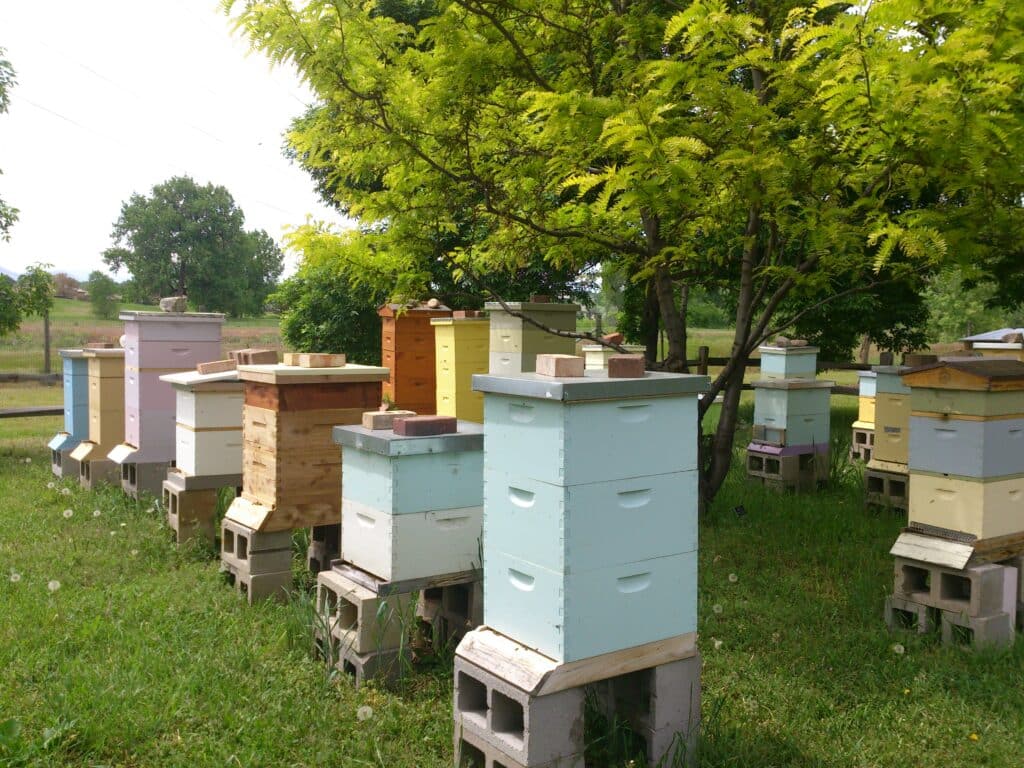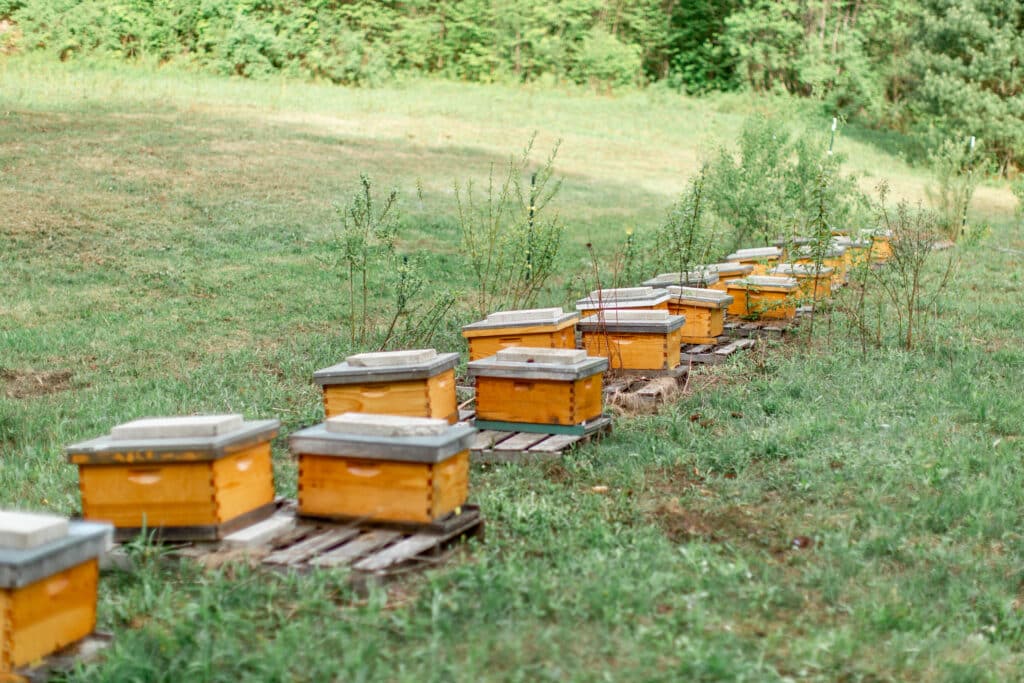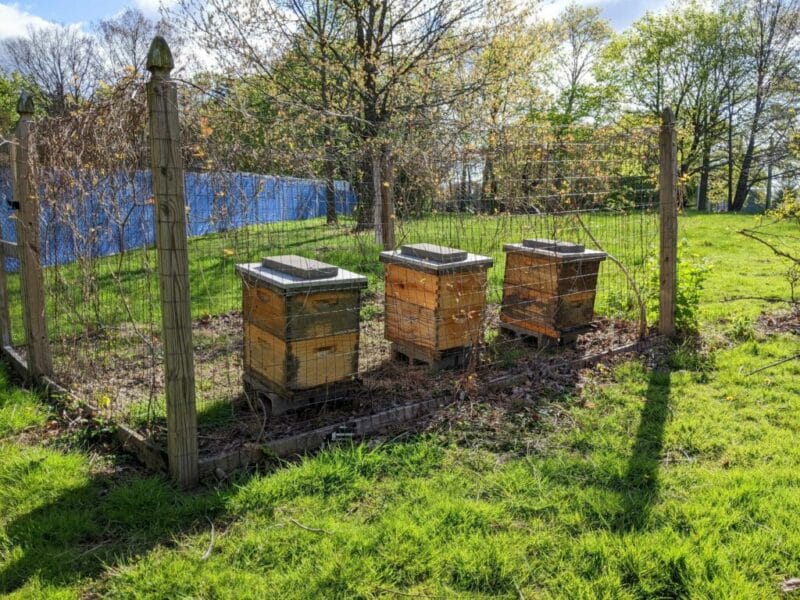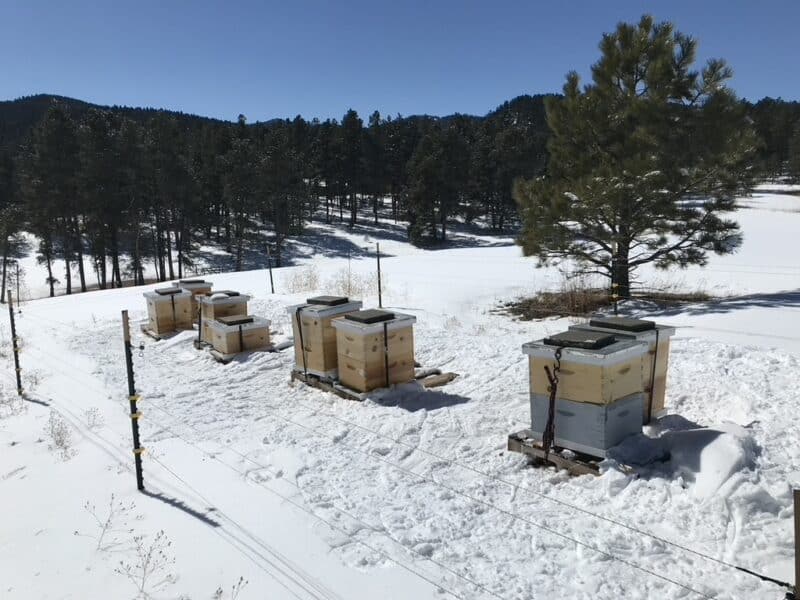Contents:
- What is an Apiary?
- Who Uses Apiaries?
- The History of Apiaries
- Benefits of Grouping Hives Together into an Apiary
- How Apiaries Benefit Agriculture
- Why Companies are Starting Their Own Apiaries
- Backyard Beekeeping: How to Start Your Own Backyard Apiary
- About Best Bees Apiaries
- FAQs
What is an Apiary?
Simply put, an apiary is a place where beehives are kept. The word comes from the Latin words for bee, apis, and place of, arium. Apiarium/apiary means “place of bees.” If you keep bees and have more than one hive at the same site — rooftop, garden, field, orchard — you have an apiary. Apiaries are also known as “bee yards.”
Apiaries can be permanent, with beehives in residence year-round, temporary, with hives stationed to pollinate specific crops, and mobile, housed on a truck or trailer so that the hives can be moved to take advantage of the needs of different crops in different geographic areas throughout the growing season.
The smallest apiary has two hives, the largest temporary apiaries (usually in agribusiness sites in the west and south east) can have hundreds. Given the availability of nearby forage, most permanent apiaries are no larger than 20-30 hives.
Who Uses Apiaries?
Everyone who keeps more than one beehive on a given site uses apiaries. There are five basic motivations for using an apiary:
1) Love of bees—usually hobbyists who enjoy watching and learning about bees;
2) Environmental activism—individuals, non-profit organizations and corporations who want to help the environment and see bees as a critical to its health;
3) Honey production—individuals and corporations who tend bees so as to harvest and sell surplus honey;
4) Pollination–farmers & orchardists who keep bees to pollinate their crops; and
5) Commercial beekeeping—companies that profit by providing pollination services to agribusinesses.
Most commercial beekeepers profit from both pollination services and honey sales. The largest commercial beekeeper in the U.S. is Adee Honey Farms in South Dakota, which transports over 82,000 hives to temporary apiaries around the country. Half of their revenue comes from pollination services provided to just two agribusiness sectors: almond growing in California and Apple growing in Washington State. Adee Honey Farms sells 4-5 million lbs of honey each year.
The History of Apiaries

The first recorded images of apiaries are from ancient Egypt. Mention of beekeeping in old Chinese texts suggests small apiaries have existed there for thousands of years as well. Until the 19th century, apiaries rarely had more than a few hives. The reason for this was that the only way to extract honey from traditional domed skeps was to cut them open and scrape out the honey, effectively killing the bee colonies each fall. Beekeepers had to start over each spring by capturing wild colonies, a difficult and unreliable way to restock their apiaries. The invention in 1852 of the Langstroth hive with its moveable frames meant honey could be extracted without harming bees. With many Langstroth hives dividing into two by swarming each spring, beekeepers could keep larger and larger apiaries. The development of queen rearing in the late 1880’s allowed for the commercial production of bees, further accelerating the number and size of apiaries in U.S.
With the advent of trucks and paved highways in the 1920’s and 30’s, honey bee colonies could be safely transported around the country to serve rapidly expanding agribusinesses. This led to the growth of large commercial beekeeping operations, using mobile apiaries to serve their agribusiness customers.
Awareness of the harm caused by agribusinesses to the environment has led to the growth of two very different types of apiaries in recent years: small apiaries that produce craft honey to serve local markets; and corporations who maintain apiaries as a public demonstration of their commitment to sustainability.
Benefits of Grouping Hives Together into an Apiary
Whenever possible, we recommend to our clients that they keep more than one hive. Grouping hives together has several benefits:
- Maintaining multiple hives reduces the risk of catastrophic loss. In northern areas, where colony loss each winter is almost 40%, keeping two or more hives means at least one of them will survive. Given that we all become attached to our bees, having an apiary with a collection of hives makes the loss of one hive easier to take.
- With two or more hives, beekeepers have more resources and options available on hand to care for the bees and solve any problems facing an individual hive. If a hive is solitary, the beekeeper has to go out and obtain the necessary fix for whatever is ailing the hive, wasting valuable time. With multiple hives on one site, beekeepers have increased ability to quickly and efficiently care for the bees.
- With varroa mite infestation common, developing one super hive per site risks loss of all bees if infestation occurs; better for beekeepers to manage two or more mid-sized hives, increasing the odds that treatment will succeed in at least one hive.
- Keeping multiple hives in an apiary helps with data collection and identification of strong colony traits. Where several colonies face the same environment, survival can indicate strong genetic traits; these healthy colonies can be bred to produce progressively stronger bees.
- Keeping several hives in one place reduces maintenance costs. Traveling between apiaries can take up as much as a third of a beekeeper’s day; servicing several hives per visit is much more efficient.
How Apiaries Benefit Agriculture
Whether you operate a small, organic farm, or a large agribusiness operation, if you have crops that need pollination to produce the fruits, vegetables and nuts that you sell, you need bees.
Rather than rely on native pollinators, who may not be sufficient for their needs, small farms will often have their own apiary with a few bee hives. These may be maintained by the farmers themselves or kept by local professional beekeepers. Even if the farm is raising just one crop, bees can forage outside the farm, finding enough food in the nearby area to satisfy their needs.
Agribusinesses, on the other hand, usually can’t keep their own bees unless they raise one crop year-round. Many agribusinesses raise just one seasonal crop, and so require a large number of hives for a very short time when that crop is in flower. As they often exist in areas where other agribusinesses are growing the same specialized crops, they offer little nourishment for bees outside that short bloom period. If these seasonal agribusinesses kept their own apiaries, the bees would eventually starve. Instead, they contract with commercial beekeepers who bring mobile apiaries to their farms.
Mobile, or nomadic, apiaries consist of a number of hives stacked on a truck or trailer that can be transported from farm to farm. While on-site, bees from these mobile apiaries pollinate their crops, and then are taken to another area to serve that area’s pollination needs. These commercial hives are constantly nourished and produce a large surplus of honey—an additional source of revenue for commercial beekeepers.
Why Companies are Starting Their Own Apiaries
Companies that listen to their constituents know that climate change and environmental degradation are big concerns today. Showing commitment to sustainability is an effective way to differentiate themselves from less enlightened competitors, helping them to attract customers, build brand loyalty and recruit talented staff. While there are many important steps companies can take, such as reducing energy consumption, improving building insulation, using recycled and recyclable materials, these are often invisible to staff and consumers.
One highly visible act that companies can take is to keep bees. Bees are living symbols of the environment; people know that they are essential to our food supply. The coverage that colony collapse disorder received in the early 2000’s has sensitized the public to their plight. Hosting a corporate apiary on a building roof is more than a symbolic gesture — it can improve the health of the surrounding environment and help increase a buildings LEED certification. Many architects, developers and property management firms have become strong advocates for corporate apiaries.
At The Best Bees Company, we work with companies large and small in a variety of industries, setting up apiaries on roof tops and ground-level gardens that are both visible, and safely away from high-traffic areas. Corporate apiaries have proven to be a very effective way for them to demonstrate their commitment to sustainability, and through programs like “name the queen,” honey tastings and events featuring honey infused food and beverages, engage their customers and employees in their sustainability programs. The response they receive from these important constituents has been overwhelmingly favorable.
Backyard Beekeeping: How to Start Your Own Backyard Apiary
There are two ways to set-up an apiary in your backyard: engage a beekeeping firm or start one yourself. If you’d like an apiary, but don’t know anything about beekeeping, hiring a beekeeping service firm like Best Bees may be the easiest way to go. You can learn more about our residential beekeeping services here.
If you already have some experience keeping bees and want to set up your own backyard apiary, you’ll need to follow these simple steps:
- Check with your state and municipal health departments to make sure you can keep bees, and if permitted, the number of hives you can keep based on your property size, and any local regulations about placement and screening.
- Find the optimal place for your apiary: this should be an open area, ideally with shelter from winter winds, away from areas where people will walk and play. If local regulations demand, the apiary may have to be a specified distance from the property line and public walkways.
- Create an apiary site plan and mark out on the ground where you’ll place each hive. You’ll need at least three feet of space between hives and between the hives and any fences or walls so that you can access them for feeding, treatment and honey harvesting.
- If you live in either a rural or urban area, you may have enough nearby forage throughout the season to sustain the hives in your apiary. If you live in a suburban location where the forage, surprisingly, is often sub-optimal, consider planting a pollinator garden, or adding pollinator-friendly plants and shrubs to your landscaping. You can find what to plant at this helpful website: https://xerces.org/pollinator-conservation/pollinator-friendly-plant-lists.
- Purchase bee boxes and set them up in cinder blocks or cement slabs according to your apiary site plan. If there isn’t a natural water source close by, add a water trough that you can clean and refill as necessary.
- If you live in an area where bears are active, you’ll need to set up an electric fence around your new apiary to keep them out.
- Purchase bees and a queen for each hive, install them, and start tending your apiary.
About Best Bees Apiaries
The Best bees Company maintains two types of apiaries:
1) on site apiaries, where we tend our clients’ bees on their property, and
2) remote apiaries, where we raise new bee colonies and clean and treat clients’ hives before returning them.
In some cases, when our commercial clients’ buildings undergo renovations or repairs, we take their hives to our remote apiaries and care for them there temporarily.
The on-site apiaries we manage for our clients can range from 2-12 hives, depending on the client’s needs and the forage available in the vicinity.
FAQs
Q: What is an apiary?
A: Apiaries are place where beehives are kept. Apiary comes from the Latin words for bee, apis, and place of, arium. In English, Apiary means “place of bees”.
Q: How many hives are there in an apiary?
A: They can be as small as two hives, or if permanent, as many as 20-30. Temporary apiaries, set up on agribusiness sites to pollinate crops for a few weeks, can have hundreds of hives.
Q: What’s a mobile apiary?
A: Mobile apiaries are stacks of beehives placed on trucks or trailers that are transported to farms to provide pollination essential to crops.
Q: Why is it better to have hives clustered together?
A: Clustering hives has several benefits, including reducing the risk of catastrophic loss, lowering maintenance costs, increasing data collected and identifying strong hives characteristics.
Q: When did apiaries become popular?
A: The first apiaries were in ancient Egypt and China. We’ve had small apiaries for millennia, but large-scale commercial apiaries didn’t become possible until the advent of the Langstroth hive, queen breeding and the development of truck transport and modern highways in the last 150 years. Backyard apiaries, which fell out of favor with the decline of small family farms, are on the rise again. Corporate apiaries are growing in popularity as companies use beekeeping as a demonstration of their commitment to corporate sustainability.








